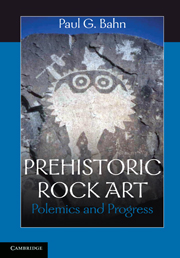Book contents
- Frontmatter
- Contents
- Figures
- Foreword by H. C. Woodhouse
- Acknowledgements
- Introduction
- 1 Art on the rocks
- 2 Myths and meanings
- 3 The emperor's new clothes I: sloppy tailoring
- 4 The emperor's new clothes II: fashion disasters
- 5 Location, location, location
- 6 The votive motive
- 7 Mustn't crumble
- Conclusion
- Select bibliography
- Index
- Frontmatter
- Contents
- Figures
- Foreword by H. C. Woodhouse
- Acknowledgements
- Introduction
- 1 Art on the rocks
- 2 Myths and meanings
- 3 The emperor's new clothes I: sloppy tailoring
- 4 The emperor's new clothes II: fashion disasters
- 5 Location, location, location
- 6 The votive motive
- 7 Mustn't crumble
- Conclusion
- Select bibliography
- Index
Summary
Rock art is also proving a tremendous draw for tourists – one need only mention well-established attractions such as the decorated European caves, Peru's Nazca Lines, the Easter Island statues, or some more recent ones such as the rock art of South Africa or Libya. This in itself poses an ever-increasing threat to its survival, along with natural factors such as weathering, floods, and fire and other man-made factors such as acid rain, vandalism, and theft. The new disaster that has hit the cave of Lascaux in recent years shows that – if even the world's best known and supposedly best protected rock art site is vulnerable – the rest of this huge but fragile and non-renewable resource must never be taken for granted.
Therefore, this final chapter will address the ever-growing problem of the management and conservation of rock art of different kinds, setting it within the framework of increasingly popular tourism, the constant problem of vandalism – not only graffiti, but also theft and deliberate damage – and of course the major recent assaults on rock art, by huge dams (in Siberia, Portugal, China) and by industrial expansion (in Australia). Examples will be given of successful restoration campaigns and prosecutions, and an assessment made of rock art's future against this background.
Natural factors
There are many natural phenomena which can affect and afflict rock art (Bahn 1998a: 257–58). For example, lightning or earth tremors can split, move, or overturn rocks (Fig. 70).
- Type
- Chapter
- Information
- Prehistoric Rock ArtPolemics and Progress, pp. 170 - 196Publisher: Cambridge University PressPrint publication year: 2010



